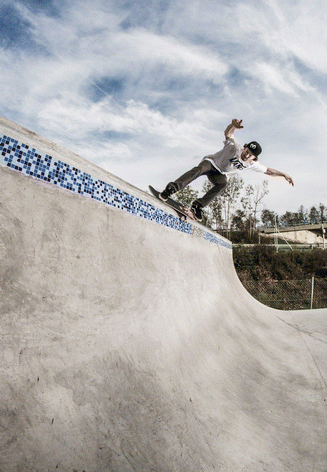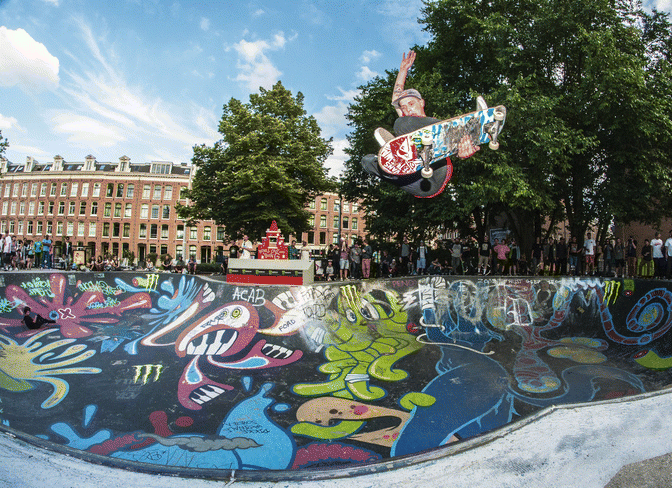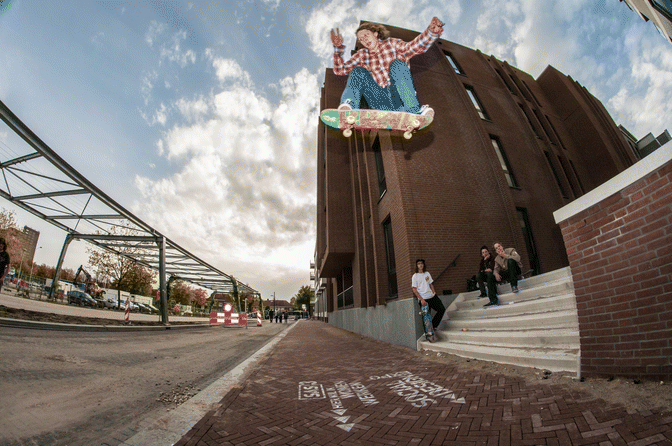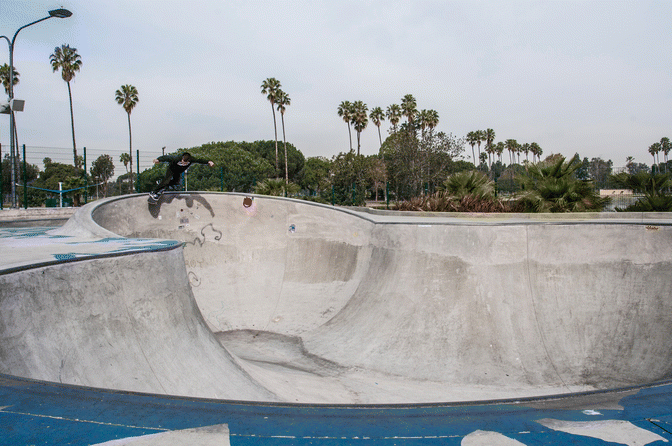Fig. 14.1
The side of a skateboard with the deck, truck, and wheels (Photo taken with permission at Railside Skateshop, Frankfurt/Main, Germany)
Between the baseplate and the hanger are the bushings that provide the cushion mechanism for turning the skateboard. The stiffer the bushings, the more resistant the skateboard is to turning. A bolt called a “kingpin” holds these parts together and fits inside the bushings. Thus by tightening or loosening the kingpin nut, the trucks can be adjusted loosely for better turning and tighter for more stability [5, 6].
14.1.3 Skateboarding Styles
A basic understanding of the skateboarding style or trick performed while being injured might help the physician to identify certain injuries and might allow him to estimate the severity of injury. Unfortunately, up to now, data on injuries suffered while performing specific skateboarding styles or tricks do not exist. Similarly, there are no figures for injuries suffered in competitive environments and by professional skateboarders [7]. Styles of skateboarding have evolved over time and are influenced by a number of factors, including sociocultural factors, mass media, and technology [7]. Styles can be broadly divided into two different categories: skateboarding to perform tricks and skateboarding as a means of transportation.
14.1.3.1 Freestyle Skateboarding
Probably the oldest style of skateboarding, freestyle skateboarding developed from the use of skateboards as a mode of transport in the 1960s. The style changed significantly with the introduction of ollies (see below) and other tricks in the 1970s and 1980s and the introduction of various obstacle elements [8].
14.1.3.2 Vert Skateboarding
Vert skateboarding has its origin, as previously described, in “pool riding” – the riding of skateboards in emptied backyard swimming pools – during the 1970s. It involves skateboard riders moving from the horizontal (on the ground) to the vertical (on a ramp or other incline) to perform tricks – hence the term “vert.”
14.1.3.3 Street Skateboarding
Street skateboarding involves the use of urban obstacles like stairs and their handrails, benches, and other street furniture. Skaters perform tricks around, on, onto, or over these obstacles [8].
14.1.3.4 Park Skateboarding
Park skateboarding encompasses a variety of substyles adopted by those who ride skateboards in purpose-built skate parks. Most skate parks combine half-pipes and quarter pipes with various other “vert” skateboarding features, as well as “street” obstacles, such as stairs and rails.
14.1.3.5 Cruising
Skateboarding is done with any type of skateboard, where riders travel as fast as possible on ramps and through skate parks or general urban areas without tricks for as long as possible without stopping or touching surfaces.
14.1.3.6 Downhill Skateboarding
Noncompetition downhill skateboarding is one of the oldest styles of skateboarding and was popular in the early 1970s, [8]. Modern riders often use longboards for races, but some use regular skateboards for noncompetition downhill skateboarding.
14.1.4 Skateboarding Tricks
There are a countless number of tricks in skateboarding (Figs. 14.2, 14.3, and 14.4); the purpose here is only to give an idea of the type of performance.




Fig. 14.2
Feeble grind. Grinds are tricks in which the trucks of a skateboard, rather than the wheels, are used to slide along an object. This is a grind in which the back truck slides along a rail, while the front truck hangs over the rail’s far side. Rider: Oliver Gordon. 24 September 2012, Wörgl, Austria (Photo courtesy of Nicola Debernardi)

Fig. 14.3
Stalefish, a trick in which the rider jumps high and grabs the skateboard in the middle with his backhand, between the feet on the side of his heels (heel side). August 2012. Rider: Jake Collins, Amsterdam, the Netherlands (Photo courtesy of Nicola Debernardi)

Fig. 14.4
Ollie. Rider: Sjoerd Vissers. 25 October 2012, Eindhoven, the Netherlands (Photo courtesy of Nicola Debernardi). In their tricks, skateboarders often grab their skateboard in different ways (Fig. 14.3) and combine aerials with rotation)
The hippie jump and the ollie are fundamental skateboarding tricks, often used as the basis of other more complicated tricks.
14.1.4.1 The “Hippie Jump”
In the hippie jump, a skateboarder rides along on a flat horizontal surface at a certain velocity. He then jumps straight up without exerting any horizontal force on the board. This allows him to fly through the air at the same horizontal velocity as the board. As a result, the board remains directly below him and he is able to land on top of it [9].
14.1.4.2 The “Ollie”
The beginning of the ollie consists of two basic actions, occurring at roughly the same time. The first action is the skateboarder jumping up and off the board. This is accompanied by him pushing down quickly on the tail end of the board, causing it to rebound off the ground and bounce back up. The skateboarder then guides the board along with his feet as it flies through the air, enabling him to land back on top of it (Fig. 14.4) [9].
14.2 Skateboarding Injuries
In the last 20 years, there has been an explosion of both the popularity of adventure and extreme sports and the participation in these activities, with skateboarding at the forefront [10]. Professional skateboarders are able to control their bodies and their boards at speeds of up to 40 miles an hour, performing complex maneuvers and tricks using various equipments such as ramps, rails, banks, ledges, and half-pipes.
As in any other sport, youngsters and amateurs are attempting to imitate those professional athletes. However, with many recreational participants lacking the necessary skills, injuries are common and can sometimes be catastrophic.
14.2.1 Statistics and Demographics
According to the National Sporting Goods Association, in 2010 in the Unites States, nearly 8 million individuals over 7 years of age participated in skateboarding more than once [11]. The vast majority of injuries occur in males, with numerous studies reporting figures exceeding 90 % [12–14]. The average age of injured skateboarders shows a variation from the mid-to-late teens up to >20 years of age, with some studies reporting injuries in skateboarders aged 40 years and older [13, 15]. The wide variation is partially explained by the different data collection methods, from both children’s hospitals and those focusing on adult medicine.
14.2.2 Skateboard-Associated Injuries
The first published report on skateboard injuries dates back to the late 1960s [16]. Since then, a continuous flow of reviews of skateboard-related injuries and descriptive studies have been published, warning of potentially serious or catastrophic injuries.
According to the National Electronic Injury Surveillance System (NEISS), it was estimated that approximately 144,000 injuries related to skateboard riding presented to hospital emergency departments in 2009 across the United States, with the vast majority affecting males under the age of 24 years [17]. It was further estimated that of these injuries affecting children, just over 3000 were of a serious nature [7]. In the study by Everett, the estimated skate park injury rate was 1.1 per 1000 users [18]. Fountain found a non-skate park injury rate of 7.0–7.5 per 1000 participants [19]. However, it is important to note that minor injuries and injuries of lesser severity treated in environments other than emergency departments will go unreported and are insufficiently captured by data sets.
14.2.3 Mechanisms and Environmental Location of Injury
Injuries in skateboarding may occur for a variety of reasons. Loss of balance and irregularities in the riding surface (stone, kerb, step, gaps between paving stones, etc.) account for the majority of injuries. Failure when attempting a trick or a jump, collision with a vehicle or an object, and skidding are other frequently reported mechanisms of injury. Depending on the specific trick attempted, the speed and the type of fall, the resulting injuries widely differ. Furthermore, new tricks are likely to change the pattern of injury.
Skateboarding parks are built to provide a safe and supervised area for skaters away from the dangers of traffic and to provide an environment containing specific obstacles designed for skateboarding (Fig. 14.5).


Fig. 14.5
Riding in a skateboarding park. Rider: Timothy Scott Misagal. California, USA 2014 (Photo courtesy of Nicola Debernardi)
Potential safety advantages of skateboard parks are numerous: good lighting, regularly maintained skating surfaces, routine structural inspection, and upkeep, enclosed areas that effectively eliminate external factors such as cars, buses, sidewalk cracks, street potholes, stones, and pedestrian traffic. Such distractions have been implicated as significant factors contributing to injury among in-line skaters and skateboarders. Skateboard parks avert these aspects and therefore represent a cleaner, more controlled skating area [18]. Despite this, many boarders still choose to skate on roads, footpaths, and parking lots, and in other public areas. Kyle and colleagues found that those requiring hospitalization were 11.4 times more likely to have been injured on a street by a motor vehicle than nonhospitalized injured skateboarders [20]. Not surprisingly, several hospitals report an increase in the frequency of skateboarding injuries when a skate park has opened nearby [18, 21].
Sheehan reported that fractures sustained in skate parks were more severe and had a severalfold higher risk of requiring manipulation or an invasive treatment when compared to injuries suffered on the street [21]. Explanations for these findings may be that in parks, more experienced skaters are attempting more complicated maneuvers, are skating faster, and therefore suffer more serious injuries. Studies investigating the specific impact of skate park design on injuries found that more injuries occurred in the ramp and bar areas compared to the half-pipe and gully areas [18]. It was suggested that this may be because the ramps and bars are the most popular attractions to the skate park users, since these design features have been popularized through commercially sponsored and televised skating competitions.
14.2.4 Injury Severity
Reported injury severity varies between the different studies. Konkien and colleagues reported a mean Injury Severity Score (ISS) of 10.5 points, which was comparable with in-line skating (10.6 points) and cycling (12.7 points) [22]. In an analysis by the National Trauma Databank (NTDB) including 2270 patients, the mean ISS was 8.6 (standard deviation 5.7), with 16.2 % of the patients sustaining severe (ISS ≥ 16) and 3.3 % sustaining critical (ISS ≥ 25) injuries [13]. The same analysis revealed an age-dependent injury pattern and severity of injuries. The incidence of severe injuries was more than 5 times more likely, and the incidence of critical injuries was more than 4 times more likely in skateboarders older than 16 years as compared to boarders younger than 10 years (Table 14.1) [13]. It is hypothesized that as skateboarders become older, and throughout their adolescent years, their physical attributes change, and their experience allows them to attempt more dangerous maneuvers at greater speeds. However, other studies found opposite results, with all catastrophic injuries sustained by those younger than 20 years of age, mentioning the long-held theory that younger children are more susceptible to head injury, due to their high center of mass and psychomotorial underdevelopment [7, 19].
Table 14.1
Skateboard-related injuries: incidence of injury severity score >15, and ≥25 in 2270 admitted skateboarders according to age groups
Injury severity score | Age group (years) | % | p-valuea | OR (95 % CI)a |
|---|---|---|---|---|
> 15 | <10 | 5.4 | – | 1.0 |
10–16 | 13.5 | 0.002 | 2.72 (1.41–5.25) | |
>16 | 23.7 | <0.001 | 5.41 (2.80–10.46) | |
≥ 25 | <10 | 1.6 | – | 1.0 |
10–16 | 1.7 | 1.0 | 1.04 (0.31–3.50) | |
>16 | 6.6 | 0.009 | 4.23 (1.31–13.72) |
14.2.5 Musculoskeletal Injuries
The majority of musculoskeletal injuries are minor, including bruises, superficial wounds, contusions, and sprains. Among the more serious lesions, fractures are the most common type of skateboard-related injuries. In the literature, the incidence of fractures in patients presenting to emergency departments ranges from 8 % up to 74 % [12, 14, 23]. Due to falling on outstretched arms, the fractures most commonly involve the upper extremity with the hand, wrist and forearm as the most frequently injured site (50 % or greater in several studies) [12, 14, 22, 24] (Fig. 14.6). Olecranon fractures (also called “skateboard elbow”) and fractures of the scaphoid, the metacarpal bones, and the phalanges have been reported and, however, are seen less frequently. Fractures in the lower extremity mainly involve the ankle (4.3–23 %) and foot (Fig. 14.7).










